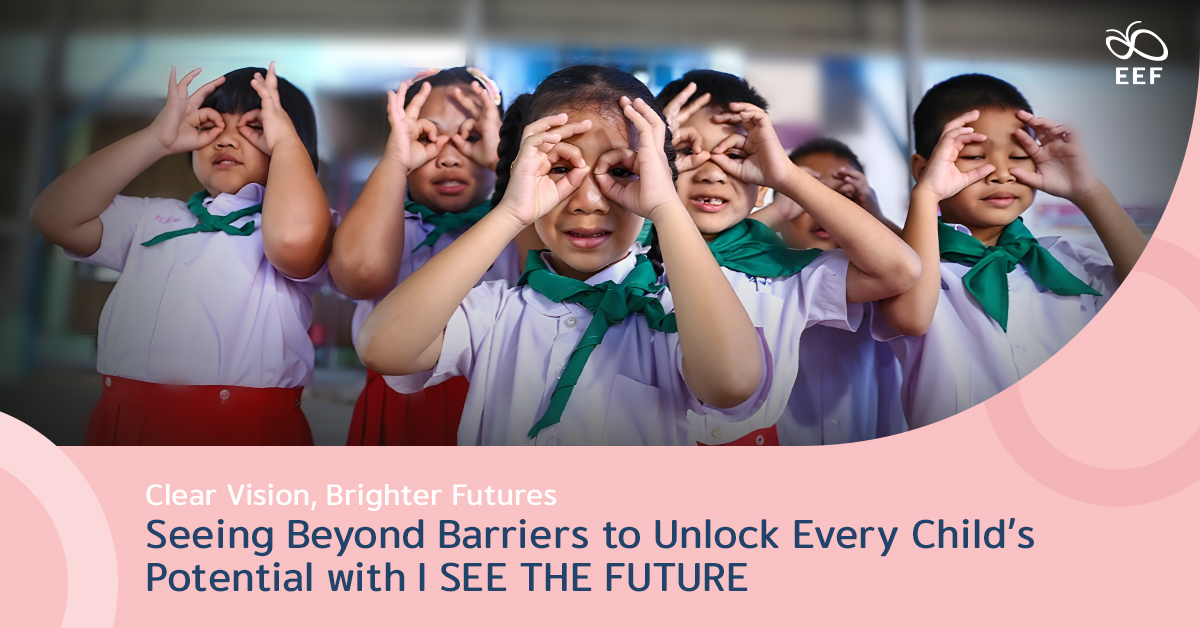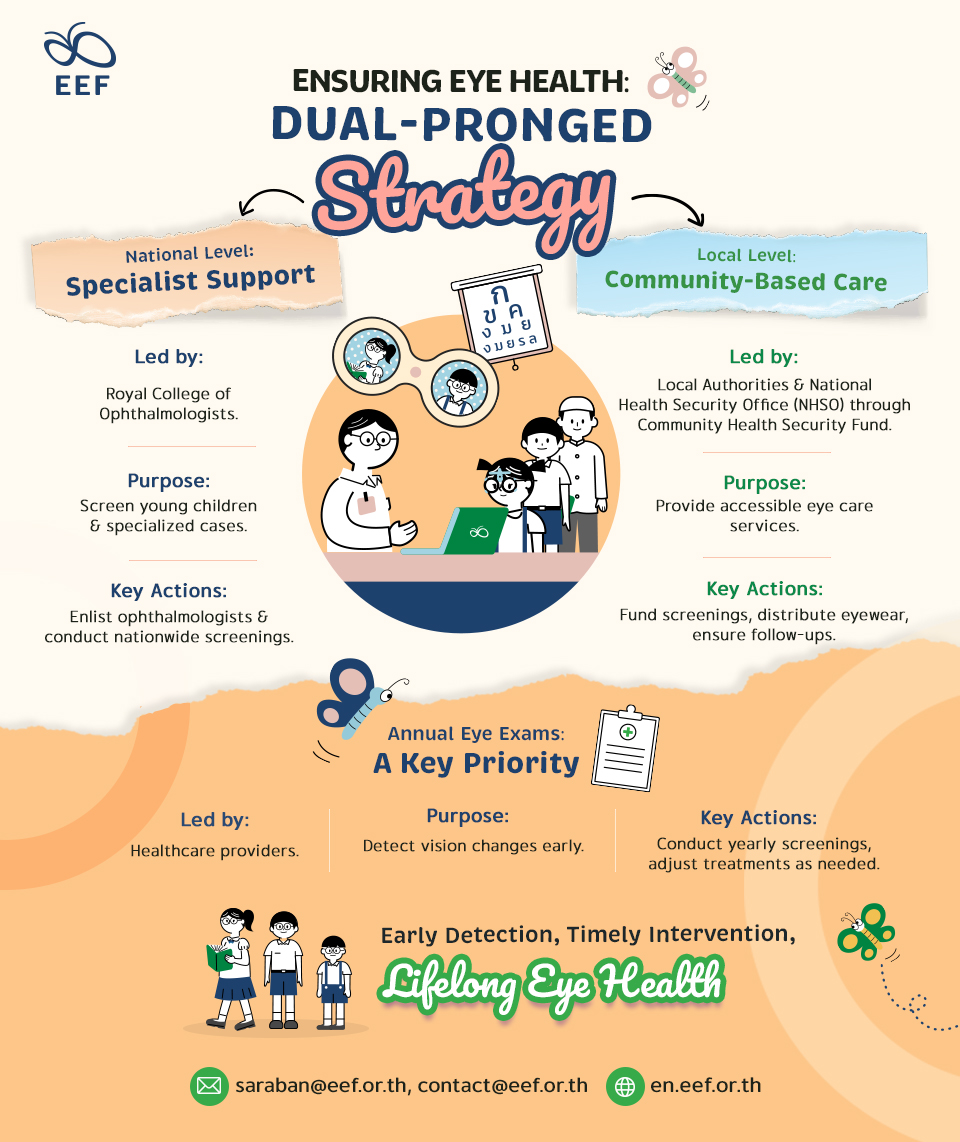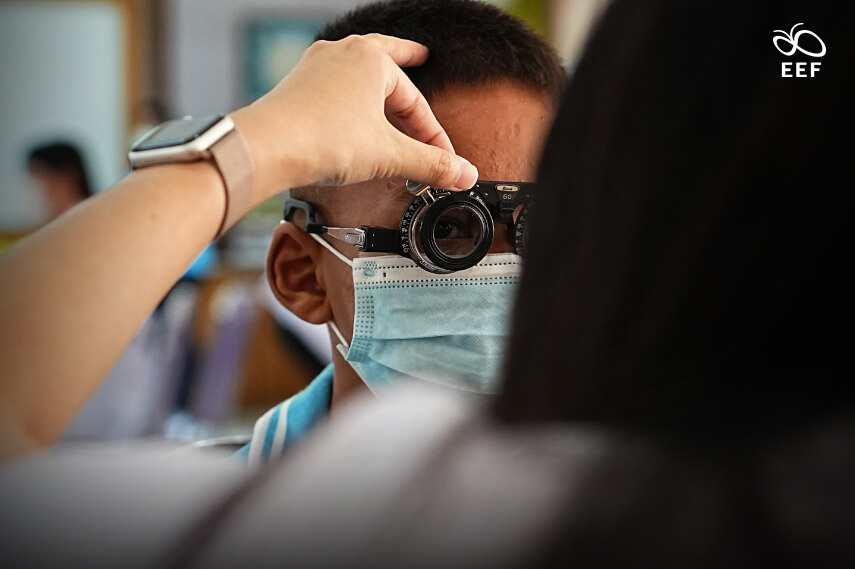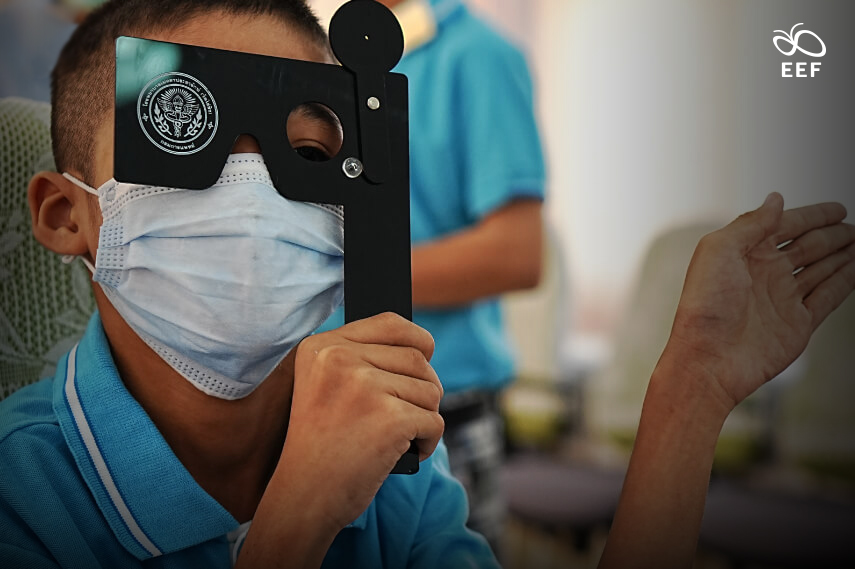
Vision impairment can significantly hinder a child’s education, limiting learning opportunities and, in some cases, leading to school dropout. Often, poor academic performance signals an underlying issue; upon investigation, it is frequently found that the cause is undiagnosed vision problem, which the children may neither recognize nor realize can be corrected with a mere pair of glasses. Addressing this challenge requires collaboration across agencies. In response, the Equitable Education Fund (EEF) Thailand and the National Health Security Office (NHSO) have launched the “I SEE THE FUTURE” project. This initiative strengthens local mechanisms to ensure all children have access to free vision screenings and follow-up treatments, removing the barriers that impaired vision poses to learning.
Since 2021, vision screening has been integrated into Thailand’s social welfare system, guaranteeing that all school children, from kindergarten to primary education, receive an initial screening. If any abnormalities are detected, children are referred for further examination by specialists. This proactive approach ensures early detection, timely intervention, and lifelong eye health, giving every child the clarity they need to succeed.

Ensuring Eye Health: Dual-Pronged Strategy
- National Level: Specialist Support
Led by: Royal College of Ophthalmologists.
Purpose: Screen young children & specialized cases.
Key Actions: Enlist ophthalmologists & conduct nationwide screenings.
- Local Level: Community-Based Care
Led by: Local Authorities & National Health Security Office (NHSO) through Community Health Security Fund.
Purpose: Provide accessible eye care services.
Key Actions: Fund screenings, distribute eyewear, ensure follow-ups.
- Annual Eye Exams: A Key Priority.
- Led by: Healthcare providers.
- Purpose: Detect vision changes early.
- Key Actions: Conduct yearly screenings, adjust treatments as needed.
Early Detection, Timely Intervention, Lifelong Eye Health
Year by year, the impact of the “I SEE THE FUTURE” initiative has become increasingly evident. A community-driven model underpins its success, with local communities playing a pivotal role in identifying and addressing children’s health challenges. Proximity to the people, coupled with an intimate understanding of local realities, has made the “Community Health Security Fund” the most effective mechanism for delivering these services. No child is left behind through this decentralized approach, which ensures that even those in underserved areas receive the care they need. With restored vision comes renewed confidence, allowing children to engage fully in both education and life.
Engagement in education and daily life, however, is not just a matter of receiving glasses but of wearing them with confidence. To address this, the initiative prioritizes not only the functionality of corrective eyewear but also its aesthetic appeal, ensuring that children feel comfortable and self-assured. Glasses should not be perceived as a mark of abnormality but as an empowering tool that enhances learning and participation; normalizing this perspective will, in time, embed vision screening and corrective eyewear as a standard feature of the educational experience. Regardless of background, every child will have the opportunity to see clearly and, in doing so, realize their full potential.

Realizing this vision requires sustainable systems of care, driven by local participation. While the NHSO allocates the necessary budget, local governments retain the flexibility to design models best suited to their communities. Given that 90% of children are in school, integrating screenings within educational institutions presents no major challenge; the greater challenge lies in reaching those who might be overlooked. To address this, mechanisms must be established to allow community members to report children who have not yet been screened. A special budget ensures that these children, too, receive the care they require. By empowering local governments to develop tailored solutions—whether by partnering with optometrists, engaging optical shops, or establishing alternative screening networks—this initiative ensures that clear vision—and with it, the promise of a brighter future—remains within every child’s reach.
To grasp the transformative power of such initiatives, one need only look to Australia’s Glasses for Kids program. Providing free vision screening, testing, and glasses to Prep to Year 3 students in disadvantaged areas across Victoria, the program ensures that undiagnosed vision impairments no longer hinder a child’s ability to learn. Backed by a 2.9 million USD allocation in the 2023/24 Budget and an additional 6.8 USD million in 2024/25, it aims to reach 74,000 more students across 473 eligible schools. While parental consent is required, participation remains voluntary. By offering on-site eye testing and free corrective eyewear, the initiative alleviates financial burdens on families while enhancing students’ engagement and academic performance. This model closely parallels the EEF’s I SEE THE FUTURE initiative in Thailand, which combines national resources with local community engagement to deliver vision screenings, corrective eyewear, and ongoing care. Both initiatives highlight the critical link between clear vision and educational success, ensuring that no child’s future is limited by an uncorrected eyesight problem.

The most effective solutions are shaped by the communities they serve, as a rigid, centralized approach cannot address the diverse challenges across regions — what works in urban centers may not be viable in remote areas, where optical shops operate under different constraints. Recognizing this, the NHSO provides broad policy frameworks while allowing localities the flexibility to design initiatives that meet their specific needs. With over 7,000 sub-districts nationwide, a decentralized model ensures resources reach those most in need and that no child is overlooked. Sustaining this effort requires financial investment and community participation; with an annual budget exceeding 3 billion baht, the NHSO and local communities ensure that decision-making remains inclusive, fostering innovation across regions, while research by the Equitable Education Fund (EEF) Thailand further refines strategies for maximum impact.
Within this framework, the I SEE THE FUTURE initiative operates under the EEF’s Education Security System, which ensures access to compulsory education for underprivileged and marginalized children. Beyond scholarships, it provides comprehensive support from early childhood to higher education, including health check-ups and SIM cards. By removing barriers and supplying critical resources, the Education Security System empowers disadvantaged children with the opportunities needed for learning, growth, and success. Every child deserves access to vision care, as clear sight unlocks not just the ability to see but a future full of opportunities for learning and growth.
All For Education is all about people; only when all is in for education is Education For All. Join the movement to reduce educational inequality. Support the EEF by donating to fund research, partnerships, and assistance for children, youth, and adults in need of educational support. Click the link to contribute today and help create a society where education is open and equal for all. Together, we can make a lasting impact.

